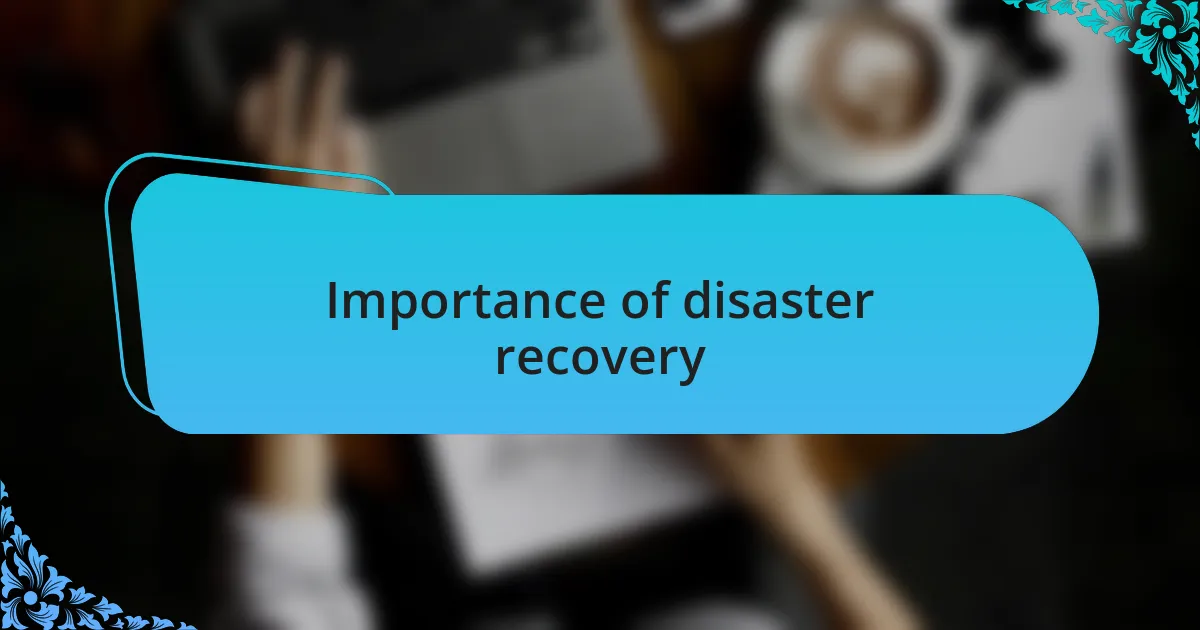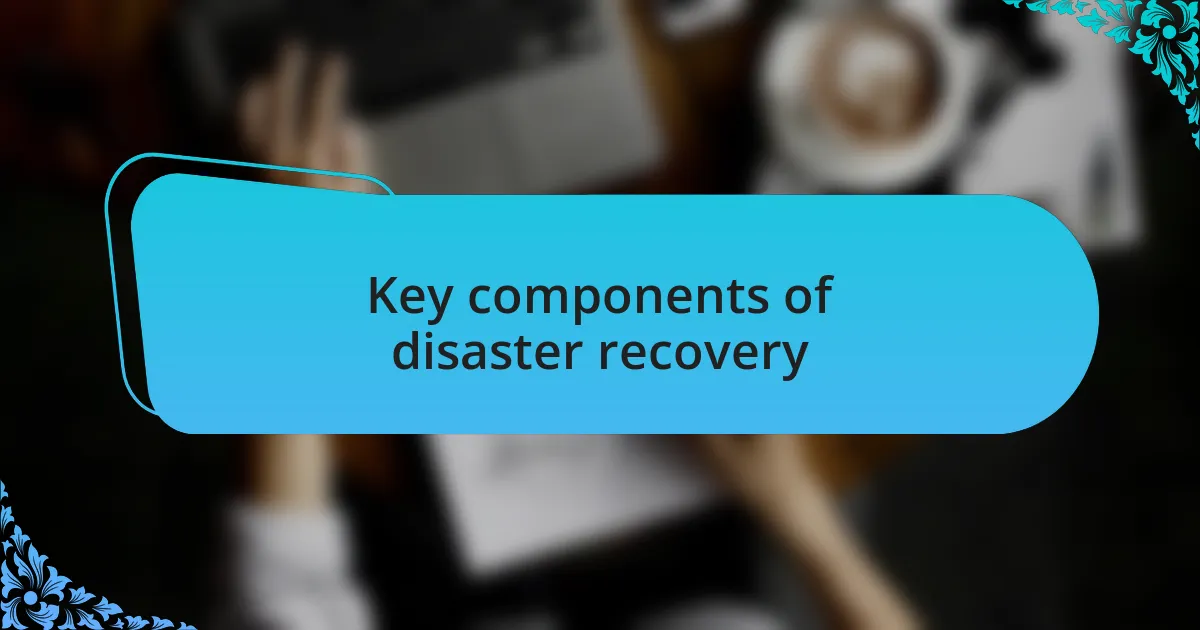Key takeaways:
- Disaster recovery planning goes beyond backups; it involves strategic preparation for unexpected disruptions and ensuring organizational resilience.
- Key components include having a comprehensive backup strategy, clear communication channels, and regular testing of recovery plans to identify weaknesses.
- For Linux systems, selecting robust file systems and automating recovery processes can drastically improve recovery time and data integrity.
- Fostering a culture of disaster recovery awareness and learning from past experiences can enhance team preparedness and operational resilience.

Understanding disaster recovery planning
Disaster recovery planning is about more than just having a backup. It’s the strategic process of ensuring your organization can recover from unexpected disruptions, whether caused by natural disasters, hardware failures, or cyberattacks. I remember a time when we faced a sudden server outage due to a power failure. That experience profoundly illustrated to me how crucial a solid disaster recovery plan is; without it, we would have faced significant downtime and loss.
When I think about the essence of disaster recovery, it strikes me as a security blanket for businesses. It’s about peace of mind, knowing that there’s a robust plan in place to safeguard your valuable data and maintain continuity. How many of us can say we’ve never experienced that sinking feeling when something goes wrong? By anticipating potential scenarios and preparing for them, we place ourselves in a better position to handle crises effectively.
Moreover, a comprehensive disaster recovery plan considers not only technical aspects but also the human side of recovery. I’ve seen teams rally together in the face of adversity, demonstrating resilience and collaboration. Isn’t it fascinating how an organization can transform a disaster into an opportunity for growth and learning? Planning for the worst certainly doesn’t eliminate the risk, but it does create an environment where preparedness fosters confidence and enables timely, efficient responses.

Importance of disaster recovery
The importance of disaster recovery cannot be overstated. In my experience, the aftermath of a disaster is often chaotic, and having a plan can be the difference between a swift recovery and a prolonged nightmare. I recall a colleague who faced a ransomware attack; their lack of preparation resulted in weeks of downtime and considerable financial loss. Isn’t it eye-opening how a single oversight can impact an entire organization?
It’s not just about technology; it’s about trust. Customers and stakeholders value transparency and reliability, and when a disaster strikes, having a solid recovery plan can reassure them that your organization is resilient. I can distinctly remember the unease in our clients’ voices after a minor data breach. However, presenting our disaster recovery strategy calmed their fears and reinforced their belief in our commitment to security.
Ultimately, a well-crafted disaster recovery plan fosters a culture of preparedness. I’ve seen teams that embrace this culture, thriving even in tough situations, demonstrating extraordinary creativity and problem-solving skills. Isn’t it inspiring to think how readiness can transform a crisis into an opportunity for teamwork and innovation? Disaster recovery planning is indeed a strategic investment, paving the way for not just survival but also growth in the face of adversity.

Key components of disaster recovery
When I think about the key components of disaster recovery, I often reflect on the importance of having a comprehensive backup strategy. In one instance, a major server failure led our team to realize we had under-prioritized our backup schedules. It was a tough lesson, but that experience highlighted how regular, automated backups can dramatically reduce recovery time. How often do you check your backup systems?
Another critical element is establishing clear communication channels. During a significant power outage, our team struggled with disjointed communication, which caused unnecessary confusion. Afterward, we put tools in place to enhance real-time updates, enabling everyone to stay informed. I believe that having a robust communication plan is essential for maintaining team cohesion during chaotic times. Don’t you think a unified message can greatly ease the stress of a disaster?
Finally, testing your disaster recovery plans is something that can’t be overlooked. I once participated in a simulated recovery exercise that turned out to be enlightening. It exposed gaps in our preparation we had never considered. I realized that regular drills not only build confidence among team members but also identify weaknesses in the plan. Could consistent testing be the secret to effective recovery?

Disaster recovery planning for Linux
Disaster recovery planning for Linux requires a tailored approach to ensure maximal resilience. I once faced a situation where our Linux-based systems encountered unexpected hardware failures, which reinforced the value of selecting the right file systems. In my experience, using robust options like ext4 or XFS not only enhances data integrity but also speeds up the recovery process. Have you ever considered how your file system choice impacts your recovery strategy?
Another essential aspect is automating recovery processes with tools like rsync or snapshot utilities. I vividly remember automating backups for our Linux servers, and it transformed our recovery time from hours to mere minutes. This experience made me appreciate how automation can eliminate human error and streamline the recovery workflow. Isn’t it comforting to know that technology can take some of the pressure off during a crisis?
Documentation also plays a pivotal role in any disaster recovery plan for Linux. I once neglected to update our README files, which led to confusion during a critical recovery moment. Since then, I’ve learned the importance of maintaining clear, up-to-date documentation that everyone can easily access. Do you keep a living document of crucial procedures, or do you think it could make a difference when disaster strikes?

My personal disaster recovery strategy
When I think about my personal disaster recovery strategy, regular testing of my backup solutions immediately comes to mind. I remember a time when I mistakenly assumed our backups were functioning perfectly. The shock of discovering they hadn’t been completed during a critical update was a wake-up call. Since then, I’ve made it a habit to test backups monthly. Have you ever experienced a similar lapse? Trust me, there’s no feeling quite like the relief of knowing your strategy is effective.
Another key component of my strategy revolves around diversity in backup locations. I used to rely heavily on one central storage device until a power surge wiped it out. In that moment, the panic was real. Now, I distribute data across multiple locations, including cloud storage and external hard drives. This redundancy means I can recover with confidence, no matter the situation. How about you? Have you considered how diversifying your backup methods could enhance your resilience?
Additionally, I prioritize simplicity in my disaster recovery approach. I recall a chaotic episode when our recovery plan involved too many convoluted steps, which led to a delay during a critical incident. Simplifying the process since then has reduced stress and made it easier for my team to execute the plan seamlessly. Have you thought about how simplifying steps in your recovery plan could save precious time in an emergency?

Lessons learned from past experiences
Lessons learned from past experiences have significantly shaped my approach to disaster recovery planning. Early on, I faced a series of unexpected failures when I neglected to document my recovery processes, which left my team scrambling during a crisis. That experience taught me the hard way that clear, written procedures are essential. Have you ever tried to recall steps under pressure? It’s not easy.
I also learned the importance of fostering a culture of awareness around disaster recovery within my team. During a project, I noticed that some members were oblivious to the existence of our recovery plan, which left our operations vulnerable. This revelation prompted me to conduct regular training sessions and discussions. Engaging everyone not only improved our preparedness, but it also strengthened team morale. How does your team stay informed about recovery protocols?
Moreover, I experienced firsthand the value of learning from previous errors. After recovering from a system crash that took longer than anticipated, I realized that analyzing what went wrong was vital for growth. Taking the time to conduct a post-mortem on incidents has led me to refine my strategies and anticipate potential pitfalls. It’s essential to ask: Are you leveraging past experiences to improve your future plans?